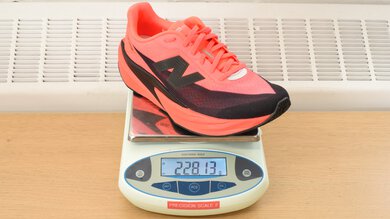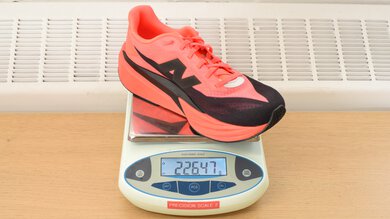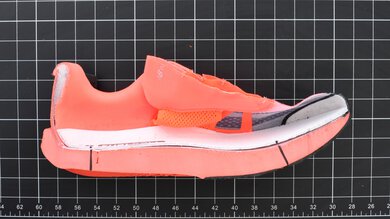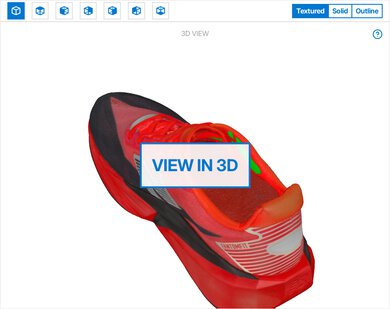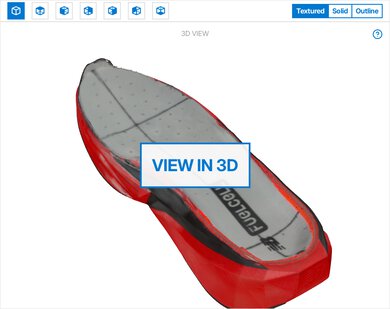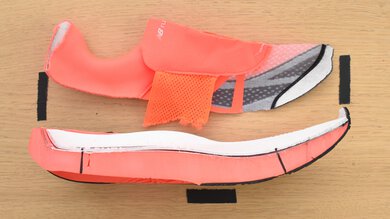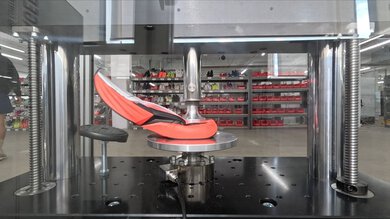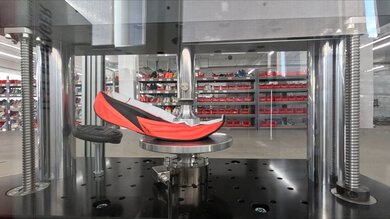The New Balance FuelCell Rebel v5 marks a notable shift in the series, moving away from earlier versions' bold, unpredictable feel and leaning into the mushy, higher-stacked trend seen across many modern daily trainers. The Rebel name was once synonymous with wild, lightweight fun: a shoe that felt fast and exciting. Version 5 dials that back, offering more underfoot protection and a more protective ride that's better suited for daily mileage and longer runs. It's no longer focused on being ultra-light, but it still retains the nimbleness that made the FuelCell Rebel v4 stand out. It may not be as rebellious as it once was, but it's evolved into a more dependable option you can confidently reach for every day.
Our Verdict
The New Balance FuelCell Rebel v5 isn't built for marathon racing, but it's not completely out of its depth either. The wide, stable platform helps preserve your running form. That said, with only some energy return and no plate, it lacks the propulsion found in true marathon racing shoes. It's best suited for runners who want a no-fuss shoe for lower-pressure marathon efforts, or for those who value comfort over raw speed.
Very stable ride.
Unplated.
Midsole isn't the most responsive.
The New Balance FuelCell Rebel v5 doesn't quite excel in 5K or 10K race conditions. The forefoot is quite firm, and the weight is on the lower side, but energy return is only average, and there's no plate to help with snap. Runners who prioritize cushioning may enjoy using it for short races, but it won't be the first pick for chasing PRs at full throttle.
Forefoot is quite firm.
The forefoot has some bounce.
Unplated.
Midsole isn't the most responsive.
The New Balance FuelCell Rebel v5 offers a mellow, forgiving ride, but it doesn't deliver much bounce in return. It lacks the snappy rebound of more energetic foams. Still, it's quite bouncy for a daily trainer, especially at the forefoot. But paired with the geometry and weight, it's not the kind of bounce that makes it effortless to pick up the pace; rather, it just adds a touch of fun and smoothness at moderate paces and during casual miles.
The forefoot has some bounce.
The heel energy return is disappointing.
The New Balance FuelCell Rebel v5 has decent cushioning due to its high stack of midsole foam. Initially, the foam compresses well, offering a plush, comfortable experience throughout the gait cycle. However, the foam isn't particularly high-end, and this becomes noticeable for runners who put more force into each step or take the shoe on longer runs, where it starts to bottom out. For those who land more lightly or use it on shorter efforts, though, it comes across as pleasantly soft and cushioned.
The heel is quite protective.
Forefoot cushioning isn't the best.
Lateral stability is a clear strength of the New Balance FuelCell Rebel v5. The wide platform underfoot keeps things feeling planted even when fatigued. Despite its soft heel foam and relatively high stack height, the shoe maintains solid structure and control, helped by excellent outsole dimensions and a firmer compound at the forefoot. It's a standout choice for runners who want something forgiving underfoot that still feels stable throughout the run.
Very stable ride.
Forefoot is quite firm.
Very wide outsole platform helps with balance.
Unplated.
Heel foam is softer and less stable.
Performance Usages
Changelog
-
Updated Dec 12, 2025:
We have updated the Popular Comparisons section to include a comparison to the recently reviewed Altra Experience Flow 2.
-
Updated Oct 30, 2025:
We've updated the Popular Comparisons section to include the recently reviewed New Balance FuelCell SuperComp Elite v5.
-
Updated Oct 23, 2025:
We updated the review to include text for the Forefoot Long Run Cushioning test, which was recently added to our test bench. Based on insights from that test, we also adjusted the Marathon Racing and Forefoot Cushioning boxes.
- Updated Oct 23, 2025: We've converted this review to Test Bench 0.9, which adds a Forefoot Long Run Cushioning test to our performance section. Read more in our changelog.
Differences Between Sizes And Variants
We tested the New Balance FuelCell Rebel v5 in men's U.S. size 9, as noted on the label for our pair. The color shown here is Urgent Red with Black and Silver Metallic. This model is also available in other colorways, including White with Black and Silver Metallic, Black with Silver Metallic and White, Mint Flash with Lab Green and Silver Metallic, and Angora with Earth Shadow and Sea Salt. Wide versions are available for both men (2E) and women (D). The design section applies only to the exact model we tested, but we expect other size and gender variants to perform similarly.
Popular Running Shoe Comparisons
The New Balance FuelCell Rebel v5 marks a shift in positioning, from a fun, lightweight trainer to something much closer to today's mainstream daily trainers. By increasing stack height, softening the midsole, and adding more upper padding, it moves toward the comfort-first design language embraced by other popular models like the ASICS NOVABLAST 5 and Mizuno Neo Zen. That's a plus for easy runs and mellow daily mileage, but it comes with trade-offs. The v5 loses some of the excitement and ground feel that once set the Rebel line apart, making it less compelling for runners who valued its unique lightweight, low-profile ride. If you're chasing that stripped-down, agile feel for daily training, there are fewer and fewer options available, with the Altra Experience Flow 2 being one of the few trainers left with a similar stack height and weight as the New Balance FuelCell Rebel v4, albeit a smaller heel-to-toe drop. On the other end, if you're looking for a true max-cushioned daily trainer, models like the Mizuno Neo Vista or PUMA MagMax NITRO offer a more cohesive and protective experience. As it stands, the Rebel v5 feels like it's searching for identity: it's soft and fun for easy runs, but less defined in terms of purpose than either its predecessors or its competitors.
The Rebel v5 now represents a shift toward comfort within New Balance's performance range, departing from its formerly sharp identity as a lightweight, speed-focused trainer. Compared to the Rebel v4, the v5 is softer, more cushioned, and more relaxed overall, focusing less on agility and more on going easy. It now overlaps more with other models, such as the Fresh Foam X 1080v14, New Balance's max-cushion neutral trainer; however, the Rebel remains more nimble. For plated performance, New Balance offers the FuelCell SuperComp Trainer v3 as a super trainer for uptempo and interval workouts, and the New Balance FuelCell SuperComp Elite v5 for racing.
For more options, check out our recommendations for the best running shoes, as well as the best running shoes for men and the best running shoes for women. If you're after shoes well-suited for long runs, check out our recommendations for the best long-distance running shoes.
The New Balance FuelCell Rebel v5 and the ASICS NOVABLAST 5 are both daily trainers that aim to blend comfort and versatility, but they approach the task in different ways. The Rebel v5 is lighter, lower to the ground, and its natural rocker works well for easy runs and strides. In contrast, the NOVABLAST 5 is higher stacked and more robust overall, delivering better cushioning and more rebound, especially for longer efforts. Its FF Blast+ Eco foam feels more dynamic and holds up better under heavier runners or higher mileage. While both shoes are on the softer side, the ASICS feels plusher overall.
The New Balance FuelCell Rebel v4 and New Balance FuelCell Rebel v5 share the same lineage, but the v5 marks a clear shift toward a more cushioned, mainstream daily trainer feel. The Rebel v4 is lower to the ground, firmer, and more responsive, making it a go-to option for runners who want a stripped-down, exciting ride when training. The Rebel v5, on the other hand, adds more stack, a softer midsole feel, and greater upper padding, making it plusher and more forgiving, especially on easy or recovery days. On the other side, it's about 20 grams heavier. For runners who love the v4's raw, fun feel, the update might feel like a step away from its original intent. For those looking for a more comfortable, cushioned version of a (relatively) lightweight trainer, the v5 broadens its appeal.
The HOKA Clifton 10 and New Balance FuelCell Rebel v5 are both daily trainers, but they serve different types of runners with very different design philosophies. The Clifton 10 is a high-stack, comfort-first shoe that emphasizes protection and impact absorption. It delivers a plush, soft ride that's ideal for easy runs, recovery days, and walks. The Rebel v5, on the other hand, is a lighter, lower-to-the-ground trainer. It's built for runners who want a bit more natural feel, with a bit of rebound and easy turnover for strides and daily mileage at a variety of paces. While both shoes are well cushioned, the Clifton feels more protective due to the higher stack of foam that helps dampen the road effects.
The PUMA Magnify NITRO 3 and New Balance FuelCell Rebel v5 are both lively trainers that nicely balance cushioning and stability. The Rebel v5 is significantly lighter and has a lower heel-to-toe drop than the Magnify NITRO 3, making the New Balance shoe marginally more stable. The plush foam in the Rebel v5's midsole provides a bit better protection, but both shoes have great cushioning. The primary advantage the PUMA shoe has is its superior energy return; while the Rebel v5 has some bounce, it lags well behind the Magnify NITRO 3 in both the forefoot and the heel's ability to respond to force.
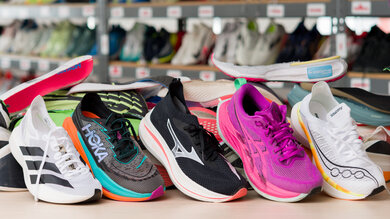
We've recently started buying and testing running shoes with a very data-oriented approach. While we're just getting started, our methodology already has dozens of tests to help you make the right purchasing decision for your needs. Not only do we use high-end equipment to gather objective data, but we also order multiple sizes of the same shoes for team members to be able to log in miles. This real-world testing is done at various paces and conditions, and with different types of workouts, to cover all the bases. This allows us to verify our results and ensure they align with what you might feel with a specific pair.
Test Results

The New Balance FuelCell Rebel v5 is slightly heavier than its predecessor, but that added weight comes with purpose. Thanks to the increased stack height and additional padding, the shoe now feels more cushioned and protective underfoot. Even so, it remains fairly lightweight for a daily trainer, making it a viable option for runners who want comfort without feeling weighed down.
There's been a significant increase in both heel and forefoot stack compared to the previous version, pushing the Rebel v5 closer to the high-stack territory seen in many modern daily trainers.
The platform is visibly wider through the midfoot compared to previous versions, especially around the arch. This added surface area improves stability and helps offset the softer foam and higher stack height. Please note that the green areas visible on the image aren't part of the shoe itself, but rather artifacts from the 3D scan.
The heel doesn't return much energy on this model. The soft FuelCell blend compresses easily, providing some impact protection but not much rebound. Heel strikers may find the rearfoot feels a bit flat when doing strides, though it remains well adapted for easier, slower efforts.
The forefoot fares better in terms of energy return. While still not explosive, there's a mild sense of rebound that adds a hint of liveliness to toe-offs. That said, it doesn't feel truly propulsive.
Cushioning in the heel is very good, as the shoe absorbs impact well across low to moderate forces. It feels protective, with enough foam to buffer landings and dampen the road. This makes it more suitable for heel strikers looking for smooth heel-to-toe transitions when tackling their everyday miles.
Cushioning in the forefoot is decent, striking a good balance between softness and structure. Compared to the previous New Balance FuelCell Rebel v4, it feels more protective, making it a bit more suitable for longer runs. However, the perception of cushioning varies depending on the runner: lighter runners and those who apply less force will benefit most, while faster and/or heavier runners may find the energy absorption plateaus as the force increases, which makes the shoe feel less protective for higher impacts.
The heel feels a bit on the soft side, which helps absorb road impact but can reduce stability. If you prefer a firmer, more stable rearfoot platform, this isn't it: consider the HOKA Mach 6 instead. That said, runners seeking a cushioned, plush sensation in the heel will likely appreciate this setup.
The forefoot is firmer than the heel, offering a more planted and controlled feel during toe-off. At lower impacts, it's only moderately firm, but it gets a lot firmer as more force is applied. This added firmness complements the rocker geometry and helps the shoe feel more grounded up front.
The New Balance FuelCell Rebel v5 offers decent cushioning at the start, but it fades relatively quickly. The absorption drops noticeably within the first 20 km and continues to decline more gradually afterward, resulting in a harsher feel as distance builds. The shoe is clearly better suited for shorter runs where its ride can shine without compromising protection.

